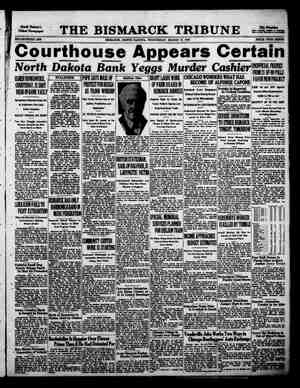New Britain Herald Newspaper, March 19, 1930, Page 5
You have reached the hourly page view limit. Unlock higher limit to our entire archive!
Subscribers enjoy higher page view limit, downloads, and exclusive features.
NEW RBRITAIN DAILY HERALD, WEDNESDAY, MARCH 19, 1930. i Turning the light of Truth on false and misleading statements in recent cigarette advertising HAT ANOTHER MANUFACTURER of cigarettes chooses to say about his product is not our affair. Even when he sees fit to misrepresent his product and leave false impressions concerning it, that still is his business —not ours. But—when, in his advertising, he goes beyond his own product and makes false state- ments or leaves misleading impressions about other cigarettes—then it is time that the truth be told. Some time ago a manufacturer of ciga- rettes used the following statements in his advertising : “The exira secret heating process removes from (=————) harmful irritants, corrosive acrids, which are present in cigarettes manu- factured in the old-fashioned way, and which cause throat irritation and coughing.” “No matter how much or how little you pay for cigarettes you have a choice of only two general classes, and not more than two. In one class you have the billions of cigarettes manufactured in the old-fashioned way and in the other class you have (————), the toasted cigarette, a product of modern science, a cigarette from which harmful irritants have been removed by that extra secret process described by the phrase ‘It’s Toasted’.” . HEN THESE STATEMENTS were first made, we assumed that they were a casual phase of that manufacturer’s advertis- ing and did not represent a deliberate and calculated policy. After making a few sach statements, he abandoned this particular form of advertising. However, other state- ments used in his advertising came to the attention of the Federal Trade Commission on a question of their truthfulness. As a result of the action of the Federal Trade Commission he was ordered to stop his admitted practice of using in his advertising false testimonials of non-smokers to the cffect that they kept slender by smoking his brand of cigarettes, and was further ordered to stop using other fake testimonials and the specious argument that all can keep slender by smok- ing that brand of cigarettes. He then began to use again the form of statement quoted above or variations of it. IF ANY MANUFACTURER chooses to say that the tobaccos he uses contain “harmful irri- tants, corrosive acrids, that are injurious to the throat,” and then to claim that these things are removed by the heat-treating process, that is his own affair. But when he tries to create the impression that it is general practice to use in cigarettes such rank tobaccos as he describes, we object to the attempted reflection on the industry. We have never used in our blend those rank tobaccos which can be properly de- scribed as containing ‘*harmful irritants, cor- rosive acrids,” nor do we believe that they are used by some of the other manufacturers. If that manufacturer wishes to advertisc heat treatment, calling it toasting or what-not, that is his right. But when, in so doing, he tries to create the impression that he is the only maker of eigarettes who treats tobaccos with heat, the truth again needs to be told. The publication of a fake testimonial is no greater perversion of the truth than to imply R. J. Reynolds Tobacco that the heat treatment of tobaccos is an exclu- sive process with any single manufacturer. HE FACT is that the use of heat treatment - in the manufacture of tobacco is about the most commonplace and universally prac- ticed method in the industry. It has long been standard practice. We use heat treatment in its most modern and scientific application, both in the prepa. ration and in the manufacture of those mild, fragrant, ripe tobaccos that carry their nat. ural goodness into CAMELS. The first CAMEL Cigarette we ever made was manufactured under the heat-treating process. Every one of the billions of CAMELS produced since has been manufactured under heat treatment. We rely upon heat to the limits of its possibilities to make our good tobaccos better. It cannot make inferior tobaccos good. WHETHER OR NOT a manufacturer, to have something to talk to the publie about, attaches a contrivance to his heat-treate ing machines to catch, condense and bottle the vapors that come from them can have no more effect toward improving the tobacco than your catching and bottling the vapors that come from your teapot would have toward improving the tea in the pot. Our own brand, CAMEL, continues 1o grow, but we are, nevertheless, unwilling to let these far-reaching false statements or ims pressions regarding the cigarette industry go uncorrected, Company Makers of CAMEL Cigarettes




